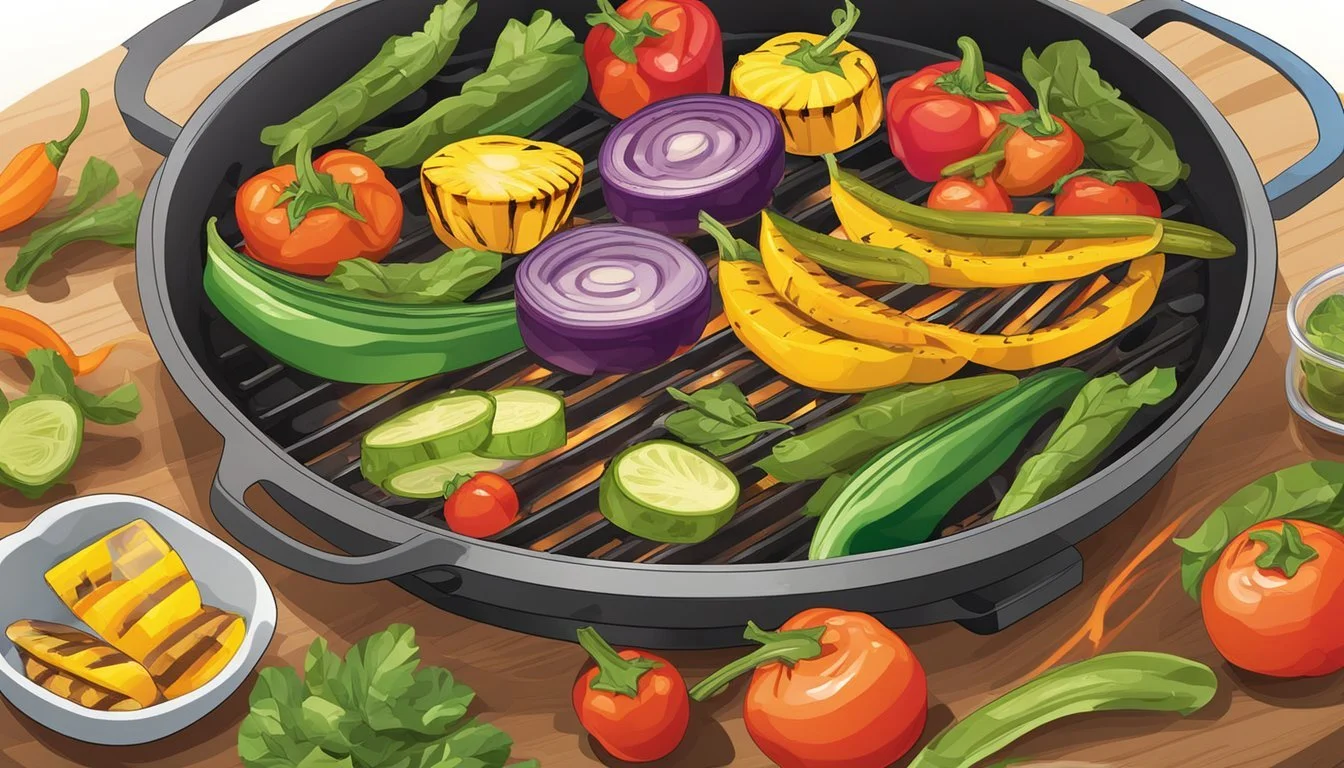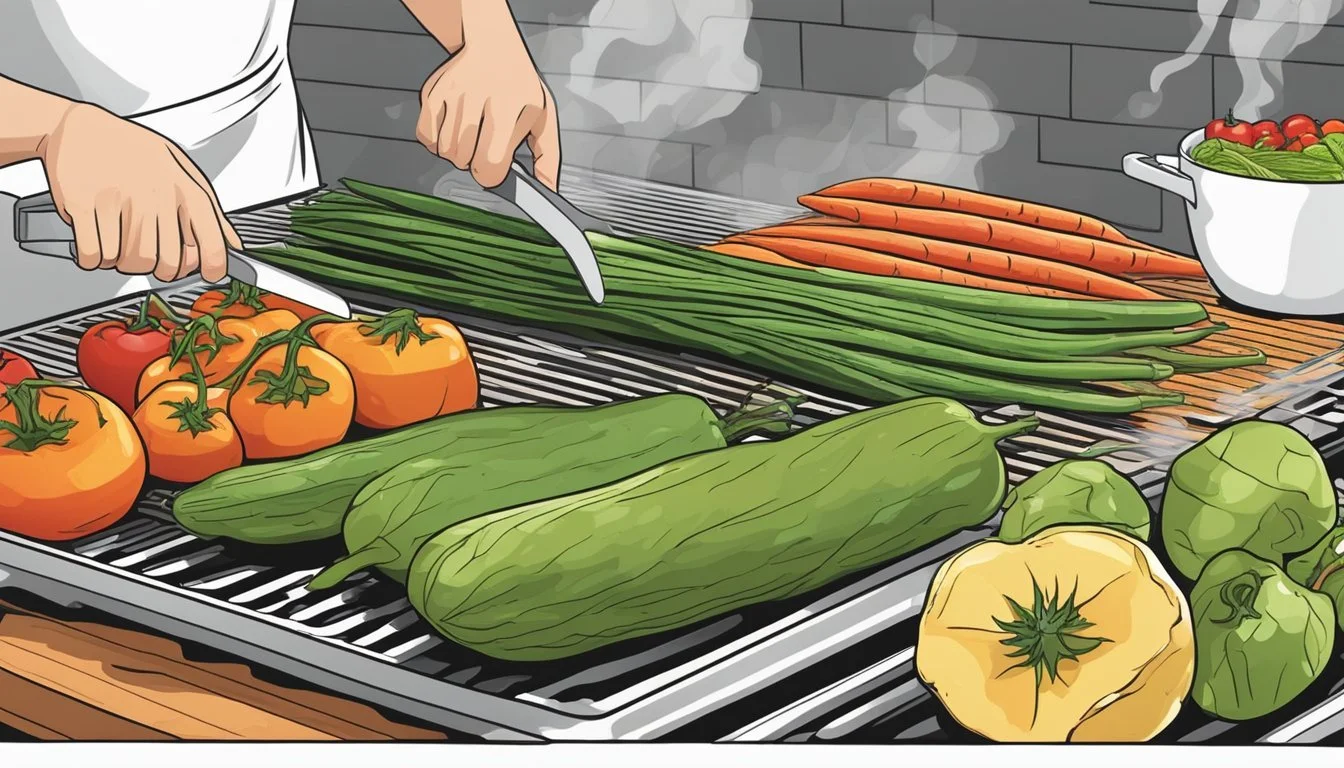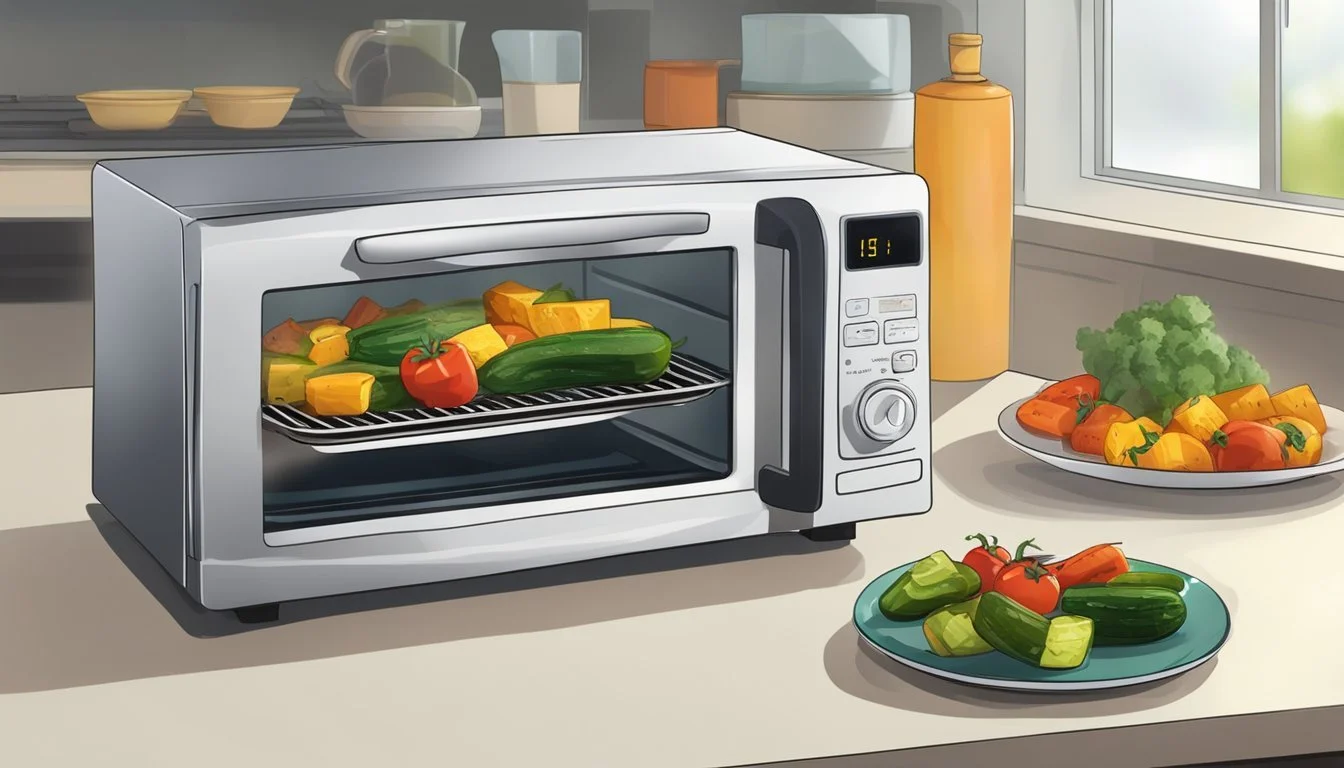How to Reheat Gluten-Free Grilled Vegetable Medley
Easy Steps for Perfect Results
Reheating gluten-free grilled vegetable medley ensures you can savor the rich and smoky flavors initially captured on the grill. These vegetables, when done right, retain their healthy, nutritious qualities while offering a deliciously warm meal. The key to reheating is maintaining the moisture and texture without compromising on taste.
For the best results, start by adding a splash of water or vegetable broth to a preheated skillet before placing the vegetables. This method helps to infuse steam, which keeps the vegetables tender and prevents them from drying out. Covering the skillet with a lid during this process will trap the steam, creating a humid environment that optimizes the reheating process.
This approach not only revives your grilled vegetable medley but also ensures that the meal remains wholesome and gluten-free. Enjoy your reheated vegetables with proteins like steak or pork chops, just as you would with freshly grilled ones.
Benefits of Gluten-Free Vegetable Medleys
Gluten-free vegetable medleys offer various health benefits, making them an excellent addition to any diet.
Rich in Vitamins and Minerals: These medleys are often packed with essential nutrients like vitamin A and vitamin C, which support eye health and boost the immune system. They also provide calcium and iron, important for bone strength and oxygen transport.
High Fiber Content: The inclusion of various vegetables ensures a high fiber intake, aiding in digestive health and promoting a feeling of fullness. This can help in weight management.
Low in Calories: Being naturally low in calories, they are an ideal choice for those looking to maintain or reduce weight without sacrificing nutritional value.
Potassium and Other Minerals: Vegetables like carrots and potatoes are good sources of potassium, which is crucial for maintaining healthy blood pressure levels.
Balanced Nutrition: These medleys contain a balanced mix of carbohydrates, minimal sugar, and essential nutrients, providing a well-rounded dietary option without gluten.
Adopting gluten-free vegetable medleys in meals can contribute significantly to overall health and wellness, offering a broad spectrum of vitamins and minerals essential for the body’s functions.
Selecting Vegetables for Grilling
Choosing the right vegetables is crucial for achieving the best texture and flavor when grilling a gluten-free vegetable medley. Focus on vegetables that can withstand high heat without losing their shape or becoming mushy.
Important Characteristics of Grilling Vegetables
When selecting vegetables for grilling, consider their water content and firmness. Vegetables with lower water content, such as zucchini, yellow squash, and eggplant, hold up well to grilling. Their dense texture allows for a good charring effect without becoming overly soft.
Firmness is another key attribute. Red bell peppers, yellow bell peppers, and carrots maintain their structure when exposed to high temperatures. Additionally, opting for vegetables that can absorb marinades, like mushrooms and asparagus, enhances their flavor profiles when grilled.
Suggested Vegetables for Optimal Texture and Flavor
Zucchini and yellow squash are top choices due to their balanced texture and ability to absorb flavors well. Eggplant provides a rich, meaty texture ideal for grilling. Red and yellow bell peppers add a sweet, robust flavor that shines on the grill.
Mushrooms, especially varieties like portobello, absorb marinades effectively and deliver a savory taste. Asparagus offers a delicate yet crispy texture that complements other vegetables in a medley. Red onions caramelize beautifully, adding a sweet note to the mix.
Vegetables like carrots, potatoes, and sweet potatoes can be pre-cooked to soften them before grilling, ensuring an even cook. Cherry tomatoes, though small, burst with flavor when grilled and pair well with other selections in a medley.
Preparing Vegetables for Grilling
When preparing vegetables for grilling, proper cutting techniques and seasoning are crucial. Well-cut vegetables ensure even cooking, while the right seasoning enhances their natural flavors.
Cutting Techniques for Even Cooking
To achieve evenly grilled vegetables, it's important to cut them to uniform sizes. For bell peppers, remove the stems, seeds, and white membranes before slicing into quarters or strips. Summer squash should be trimmed at the ends and sliced into long strips or rounds. For zucchini and yellow squash, thick slices work best. Onions can be cut into thick rounds or wedges to ensure they hold together on the grill. Portobello mushrooms require the stems removed, and the caps can be grilled whole or sliced into thick pieces.
Consistency in size ensures the vegetables cook at the same rate, preventing some pieces from burning while others remain undercooked. A sharp knife is essential to make clean cuts and reduce damage to the vegetables.
Seasoning for Enhanced Flavor
Seasoning vegetables before grilling brings out their flavors and adds depth. A basic mix of olive oil, kosher salt, and black pepper is an excellent starting point. Olive oil helps prevent sticking and adds a rich taste. Garlic, minced finely, can be sprinkled over the vegetables for an aromatic boost.
For a Mediterranean touch, add Italian seasoning, thyme, or red pepper flakes. Sea salt or kosher salt ensures the flavors penetrate the vegetables more effectively, and a hint of black pepper provides a mild heat. To add a tangy note, a simple balsamic vinegar marinade combined with olive oil, salt, pepper, and herbs like thyme can be used to coat the vegetables before grilling. Adjusting seasonings to personal preference can make a significant difference in the final taste.
Grilling the Vegetable Medley
Achieving perfectly grilled vegetables requires attention to grill temperature, precise grilling techniques, and the use of tools like skewers or grill baskets. By focusing on these elements, the vegetables will cook evenly and develop delicious grill marks.
The Right Grill Temperature
For a gluten-free vegetable medley, preheat the grill to medium-high heat (around 400-450°F). This temperature helps ensure the vegetables cook through without burning. Use a grill thermometer to monitor the heat. A well-maintained grill will ensure consistent temperature for even cooking.
Grilling Techniques for Perfect Vegetables
Arrange the vegetables in a single layer on the preheated grill. Turn them occasionally to achieve even cooking and distinctive grill marks. Different vegetables have varying cooking times; start with denser vegetables like carrots and bell peppers, and add softer ones like zucchini later. Lightly coat the grill grates with oil or non-stick spray to prevent sticking.
Using Skewers and Grill Baskets
Skewers and grill baskets simplify grilling smaller or unevenly shaped vegetables. Thread vegetables onto skewers, leaving space between pieces for even heat distribution. For a mix of small vegetables, a grill basket ensures they don’t slip through the grates. Both methods aid in achieving consistent grill marks while making it easy to turn multiple vegetables at once.
Reheating Grilled Vegetables Without Losing Flavor or Texture
When reheating grilled vegetable medleys, preserving their flavor and texture is crucial. Selecting the appropriate method ensures tenderness and avoids overcooking or drying out.
Best Methods to Reheat on Stovetop
Reheating on the stovetop is efficient and effective. Start by preheating a skillet over medium heat. Add 1-2 tablespoons of water or vegetable broth immediately after adding the vegetables. This liquid vaporizes, creating steam that retains moisture.
Cover the skillet with a lid to trap steam, helping maintain a tender texture. For added flavor, include a few drops of oil or toss in some minced garlic or herbs. Make sure to stir occasionally to avoid sticking and ensure even heating.
Reheating in the Oven or Toaster Oven
The oven or toaster oven method is excellent for preserving the grilled flavor. Preheat the oven to 375°F (190°C). Spread the leftover vegetables evenly on a baking sheet. To prevent them from drying out, spritz the vegetables lightly with oil or butter.
Cover the baking sheet with foil to lock in moisture and heat for about 10-15 minutes, checking periodically for desired warmth. This method ensures even heating and retains the oven-roasted texture.
Using a Microwave with Caution
Microwaving can be convenient but requires careful attention to avoid losing texture. Place the vegetables in a microwave-safe dish and cover with a microwave-safe lid or damp paper towel. This retains moisture and helps in even reheating.
Set the microwave to medium power and heat in short bursts of 30-45 seconds, stirring between intervals. This prevents overheating, ensuring the vegetables remain tender. The microwave method is less ideal for maintaining the grilled texture but works well in a pinch.
Serving Suggestions for Reheated Vegetable Medleys
Reheated gluten-free grilled vegetable medleys can be enjoyed in various ways, complementing different meals and catering to diverse dietary preferences. These versatile vegetables can be served as standalone dishes, paired with proteins, or incorporated into other meals.
As a Standalone Side Dish
Reheated grilled vegetable medleys make an easy and healthy side dish. Simply season them with a little extra salt, pepper, and herbs like thyme or rosemary. Drizzle with a touch of olive oil for added flavor. Serve warm to bring out their natural sweetness and maintain the desired texture. These medleys work well for both casual and formal dining settings, providing a burst of color and nutrients to any meal.
Pairing with Proteins
Vegetable medleys pair wonderfully with a variety of proteins such as steak, chicken, and fish. For a hearty meal, serve them alongside grilled or roasted meats, allowing the vegetables' flavors to complement the savory richness of proteins. For a lighter option, combine them with baked or grilled fish. Vegetarian diners will enjoy pairing vegetables with protein-rich sides such as lentils, chickpeas, or quinoa, ensuring a balanced and nutritious meal.
Incorporation into Other Meals
Incorporating reheated vegetable medleys into other dishes adds depth and variety. Add them to sandwiches for a healthy crunch and flavor boost. They can also be mixed into pastas, rice dishes, or quinoa bowls for an extra layer of texture and taste. Toss them into salads for a quick and vibrant meal, or use them as pizza toppings for a unique twist. Their versatility makes it easy to enhance a range of meals with minimal effort.
Additional Tips and Variations
Explore these methods to maintain the nutritional value of your gluten-free grilled vegetable medley during reheating and enhance the flavor with creative seasoning combinations.
Maintaining Nutritional Value During Reheating
To keep the vitamins and minerals intact, consider reheating using steam instead of direct heat. Add a small amount of water or vegetable broth to a preheated skillet and cover. This moisture content creates a humid environment, reducing the loss of nutrients.
Another method is the microwave technique. Add a few drops of water to the vegetables, cover them with a microwave-safe lid or damp paper towel, and reheat on medium power. This keeps the vegetables moist and prevents nutrient degradation.
For oven reheating, use a low temperature setting. Preheat the oven to 250°F (120°C). Place the vegetables in an oven-safe dish with a dash of olive oil. Cover with aluminum foil to lock in moisture, which preserves the nutritional content.
Creative Seasoning Combinations to Try
Experiment with different seasoning blends to add variety to your gluten-free grilled vegetable medley. An Italian mix can include garlic powder, oregano, and basil with a splash of balsamic vinegar. This gives a robust and savory flavor.
For a Mediterranean twist, try a combination of sea salt, black pepper, lemon zest, and fresh thyme. These simple ingredients refresh and enhance the vegetables' natural flavors.
If following specific dietary plans like keto or paleo, use herb-infused oils. For example, rosemary or thyme infused olive oil pairs well with grilled vegetables. These oils not only add flavor but also complement the dietary needs.
Additionally, a spicy kick can be achieved with smoked paprika, cayenne pepper, and a hint of lime juice. This seasoning mix is perfect for those who love bold flavors while keeping the dish gluten-free and keto-friendly.







